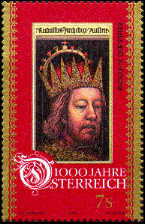
| Austria Cafe |

History
|
The Alpine lands and the fertile plains of the Danube Region were settled in prehistoric times. The existence of rich mineral resources - most notably salt and iron - gave rise to a prosperous Celtic culture which established itself as a major trading partner of the neighbouring Roman territories during the first century BC. Around the birth of Christ this region, known as the kingdom of Noricum, was conquered and subsequently incorporated in the conglomerate Roman Empire and became a Roman province - along with Rhaetia (western Austria), which the Romans subdued at the same time, and Pannonia (western Lower Austria and Burgenland). The Romans held sway in the Danube region for almost five hundred years. When they finally gave way to the onslaught of the tribal migrations and withdrew from the Danube, they left behind them several once-thriving cities. |
|||||||||||||||
|
Up to the late eighth century the area of present-day Austria was repeatedly crossed by waves of migrating peoples. The German tribes crossed the Danube on their way south, while the Huns with their hordes of horseback warriors swept eastwards as far as France. Later the Avars settled in eastern Austria, and the Bavarians edged their way down the Danube. Pockets of Slav settlers lived in the north of Lower Austria, in Carinthia and in southern Styria. Towards the end of the eighth century Charlemagne established the Carolingian Mark between the Danube and the Drau as a bulwark against further encroachments of the Avars. Since the departure of the Romans, Irish and Scottish monks had progressively christianised the Alpine region. |
||||||||||||||||
|
When the Bavarian dynasty of the Babenbergs was entrusted with the administration of Austria in 976, it was still sparsely populated. In the ensuing centuries the Babenbergs pursued an astute strategy of aggrandisement, and a shrewd policy of morganatic marriages helped them to establish themselves as one of the most powerful dynasties in the Empire. In 1156 Austria was declared a Duchy and its rulers granted several important privileges. By the time the Babenberg dynasty died out in the middle of the thirteenth century, they had considerably enlarged the area under their sway.
|
||||||||||||||||
|
In 1282, after the brief interregnum marked by the reign of Ottokar II Premysl, the Habsburgs - whose origins lay in Swabia - were invested with the Duchy of Austria. With great dexterity they set about steadily enlarging their power base, acquiring the Duchies of Styria, Carinthia and Tyrol through contracts of succession and then adding Gorizia and Istria (with Trieste) to their territories. Finally, in 1437 Duke Albrecht V, who was married to the daughter of Emperor Sigismund, became the first Habsburg to wear the imperial crown after his father-in-law's death. |
||||||||||||||||
|
In the following centuries Albrecht's successors were all - with brief exceptions - crowned Holy Roman Emperors. The Habsburgs cleverly employed strategic marriages to enlarge their territories, acquiring Burgundy and the Low Countries in this way, and soon a Habsburg also occupied the Spanish throne. In 1522 the dynasty split into a Spanish and an Austrian line. In 1526, after the Jagiellonian dynasty had died out, the Austrian Habsburgs added Bohemia and Hungary to their lands. Throughout the sixteenth and seventeenth centuries the dominant theme of Austrian history was the confrontation with the Ottoman Empire, whose vast armies twice laid siege to Vienna. Having reversed the Ottoman thrust into Europe, Austria acquired new territories and emerged as a major European power. |
||||||||||||||||
|
In the second half of the eighteenth century Empress Maria Theresa and her son Joseph II implemented sweeping programmes of reform, laying the foundations for a modern state administration. The upheavals that followed the French Revolution and the Napoleonic Wars swept away the Holy Roman Empire, and in 1806 Franz II abdicated from the imperial throne. Two years previously he had followed Napoleon's suit in declaring Austria an empire.
|
||||||||||||||||
|
In the wake of Italy's emergence as a nation, Austria suffered a succession of crushing defeats, and the Habsburg administration was forced to make several concessions to the rapidly burgeoning nationalist movement. In 1867 Emperor Franz Joseph acceded to demands for the creation of the Double Monarchy of Austria-Hungary. This conglomerate entity disintegrated at the end of the First World War, not least as a result of the centrifugal forces of nationalist self-assertion. |
||||||||||||||||
|
Now the rump of what had once been an empire, Austria was proclaimed a Republic in 1918. But reduced to the dimension of a small state, it had difficulty finding its place in the new European order. In 1938 Austria succumbed to the inexorable pressures of Hitler's Germany and internal instability. With the help of the Allied Powers, Austria was revived as a Republic in 1945 but remained occupied by the armies of France, Britain, the Soviet Union and the United States until 1955, when the Austrian State Treaty was signed. In the same year the Austrian Parliament enacted a constitutional law on the country's status of permanent neutrality, and before year's end Austria had joined the United Nations. In the ensuing decades this country has gained a recognised position in the concert of European nations. After years of endeavour, Austria became fully involved in the European integration process when it joined the European Union on January 1, 1995. |